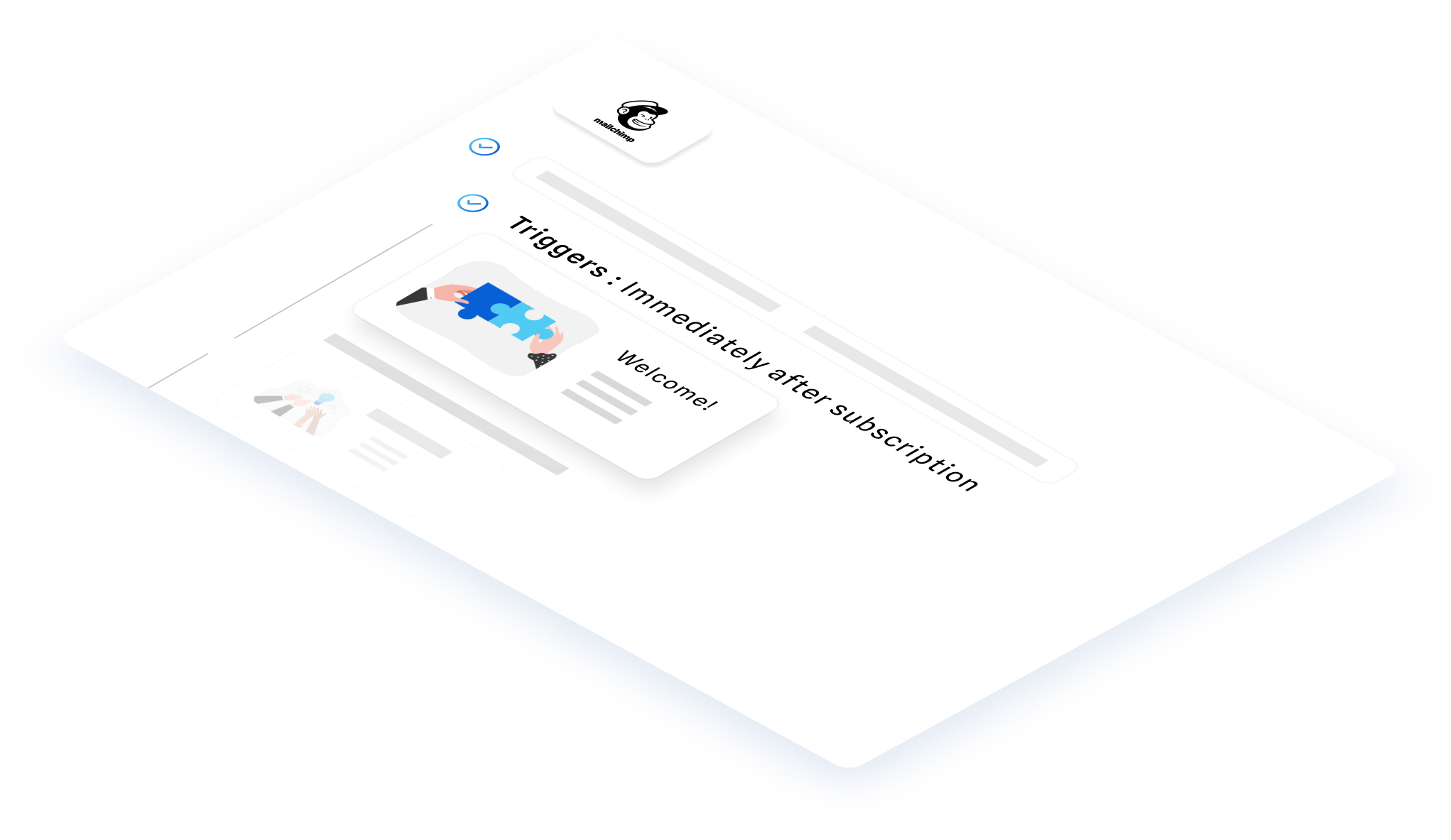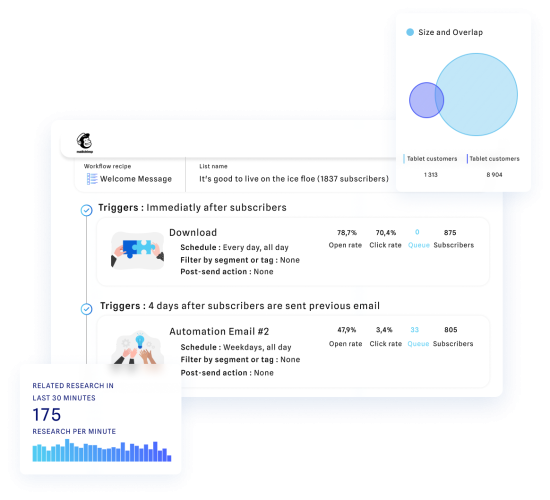
Newsletters:
The Ultimate Guide
The newsletter serves as your company’s official information bulletin. Discover why it’s essential, how to create one, and the strategies to maximise its effectiveness.

What is a newsletter, when to use it, and why?
What is a newsletter?
A newsletter is a form of e-mail communication. It’s regularly sent to contacts on a distribution list, including prospects, clients, subscribers, partners, and employees. Its primary purpose is to provide valuable information to recipients, fostering long-term relationships. You may refer to it as an “information letter” or an “infoletter.” Essentially, the newsletter acts as your company’s official medium of communication, particularly considering the widespread use of e-mail by internet users. However, it’s important to note that newsletters are not intended for product or service promotion and should not be treated as marketing tools!

What can you put in a newsletter?
While a newsletter always serves an informative purpose, its content can take many forms. You can communicate the latest published articles, company or brand news, upcoming events, introductions of new team members, industry updates, stories from your customers or partners, testimonials from prospects and clients, and more. Whatever the content, the newsletter should make people interested in the company, its industry, and everything surrounding it. That’s why it’s also important to choose your list of recipients carefully!

Newsletter vs E-mail Marketing
Newsletter
- Inform: providing added value to the recipient, staying in touch, fostering loyalty
- Informative, relevant, or entertaining: news, tips, tricks, special offers…
- Personal, intimate, emotional (personalised e-mails)
- Exclusively sent to newsletter subscribers
- Regular and predictable: weekly, monthly, etc.
VS
Email marketing
- Persuasive: encouraging the recipient to take action, generating leads, making sales
- Argumentative, company or brand-focused: product or service presentations, promotional offers…
- Professional, commercial
- Contacts from a qualified and segmented database
- Strategically timed: during product or offer launches, etc.
What is the purpose of a newsletter?
A newsletter is an information letter and should not be confused with e-mail marketing. But what is it used for?
-
Informing people about the company
Communicating the latest updates about the company or brand to subscribers who follow and want to know more.
-
Sharing content
Sharing content published on your website with your mailing list to attract attention and encourage reading or downloading.
-
Communicating easily
Sharing information with prospects and clients, as well as internally with colleagues, partners, and anyone interested.
-
Generating traffic
Encouraging recipients to click on links within the e-mail, directing them to blog articles, premium content, or the website itself.
-
Increasing visibility
Boosting your website’s search engine optimisation by driving more traffic through a high click-through rate on e-mail links.
-
Building relationships
Creating a community of subscribers and nurturing trusted connections, with the goal of converting them into customers or fostering loyalty.
-
Understanding your audience
Gaining valuable insights into your audience by analysing e-mail statistics, enabling you to practice targeted e-mail marketing.
-
Retaining your audience
Maintaining regular communication with subscribers to cultivate a strong, long-term relationship with a dedicated audience.
-
Saving costs
Taking advantage of the outstanding ROI offered by e-mail marketing, which remains one of the most cost-effective communication channels for businesses.
-
4B
people worldwide
use e-mail. -
72%
of consumers
prefer to be contacted via e-mail. -
28%
is the average ROI
of e-mail marketing.
Key Steps to Crafting an Effective Newsletter
Creating a newsletter: Turning theory into practice
How can you create a high-quality newsletter that resonates with recipients?

-
Step 1
Define one or multiple objective(s)
The primary goal of a newsletter is to inform. But what exactly do you want to inform your readers about? To create a top-notch newsletter, you need to consider the bigger picture. What specific goals are you aiming to achieve through your e-mail communications? Building brand awareness, educating your audience about product usage, boosting sales, fostering customer loyalty, internal communication… the possibilities are endless.
-
Step 2
Build a mailing list
Start by creating a targeted contact list for your newsletter. Strategically placed sign-up forms on your website and social media platforms will encourage users to subscribe. Once you’ve assembled your list of recipients, segment it based on the objectives of your newsletter (prospects, clients, employees, partners, etc.).
-
Step 3
Craft compelling e-mail content
The content of your newsletter will depend on your objectives and the specific audience you’re targeting. However, there are some general guidelines to follow. Create clear and attention-grabbing subject lines, structure your e-mails in a way that effectively conveys information, use formatting to improve readability, include relevant links and call-to-action buttons, and consider using the sender’s name.
-
Step 4
Apply your company’s branding
Remember that your e-mail messages represent your company or brand. Therefore, they should adhere to the established branding guidelines used across all communication channels (website, brochures, social media, etc.). Consider engaging the expertise of a graphic designer to ensure that your e-mail design maintains quality and consistency.
-
Step 5
Test and send the newsletter
Before sending out your newsletter, conduct thorough testing on various e-mail clients and devices to ensure the display is optimal and prevent messages from being flagged as spam. Double-check all links within the e-mail content. Once you’re satisfied, distribute the newsletter to your mailing list. Afterwards, monitor performance using relevant metrics such as deliverability rate and open rate.
How should you share your newsletter?
Unless you have the time (and courage) to manually send each e-mail to every recipient, it’s highly recommended to use a mass e-mail distribution tool. There are numerous solutions available on the market, including Sendinblue, Sarbacane, MailChimp, MailJet, and more. While these tools often include built-in e-mail creation features (often with drag-and-drop editors that require no coding), it’s a good idea to collaborate with a skilled graphic designer who can ensure that your newsletter aligns with your company’s branding and objectives.

-
43%
– the rate of e-mails
received and opened on mobile devices. -
67%
of internet users
are subscribed to more than 6 newsletters. -
77%
of e-mail ROI
comes from well-targeted and segmented campaigns.
Practical tips to make your newsletter compelling
Add a subject line that inspires recipients to open your e-mail
Just like any e-mail, a newsletter should capture the recipient’s attention and encourage them to open it. Even though they have subscribed to receive it, that doesn’t guarantee they’ll actually read it! That’s why it’s crucial to write something to pique their interest, starting with what they see first: the subject line. For maximum impact, personalise the subject line by using the recipient’s name and using the data you’ve collected about their interests, behaviour, or industry. Make a clear and realistic promise in the subject line, one that you will deliver in the main body of the e-mail. Attract their attention with thought-provoking questions, compelling statistics, or significant announcements. And to improve your open rates, avoid using any “forbidden” terms that might trigger spam filters and make your e-mail appear less genuine.


Write clear and accessible newsletter content
Creating a high-quality newsletter also means creating engaging content. It should align with the e-mail’s subject and avoid making false promises or deviating from the main topic. Keep in mind that recipients often read newsletters on the go or with limited time, so you should make it easy for them to consume the information. Structure your paragraphs effectively, use concise sentences with simple language, write in the present tense, get straight to the point, and enhance the content with relevant images, GIFs, or even videos. Don’t forget to include external links or compelling call-to-action buttons to drive further engagement.
Choose the right sending frequency for your e-mails
The frequency of sending a newsletter plays a crucial role in its success. It’s important to think in the long term and foster loyalty. What is the ideal frequency? Every week? Once a month? Quarterly? To determine the perfect timing, consider the regularity of the information you want to share. Each newsletter should bring something valuable to your recipients, which is a prerequisite for boosting your open rates. Above all, avoid sending newsletters just for the sake of it! It’s better to send a high-quality newsletter once every quarter, ensuring you have meaningful content to share, rather than bombarding your subscribers weekly with empty messages. Moreover, it’s not only about the frequency of sending but also about consistency. Once your mailing list gets used to a specific sending schedule, it’s crucial to maintain it consistently over time.

Choose the right moment to send your information letter
Which are the best days to send a newsletter to your prospects and clients? When are your employees more likely to pay closer attention to internal e-mails? These questions are vital because e-mails received at the wrong time may simply get ignored. It’s essential to determine the optimal window of opportunity. However, keep in mind that each audience segment is different. Professionals tend to read their e-mails upon arriving at the office in the morning or after lunch breaks, while individuals tend to check their inboxes before or after work (including weekends). To find out the ideal timing, conducting tests is indispensable.
-
83%
of businesses
use newsletters in B2B marketing. -
59%
of consumers
are influenced by e-mails when making purchasing decisions. -
26%
– the additional open rate
recorded for e-mails with personalised subject lines.
Strategies to improve the performance of a newsletter
Deliverability rate :
ensuring your newsletter reaches its destination
Two key performance indicators for a newsletter are deliverability and open rate. The first of these indicators is crucial: for an e-mail to be read, it must first land in the recipient’s inbox! How can you ensure a good deliverability rate and prevent your sent e-mails from ending up in spam folders? Here are the essential points to consider.


-
Reputation control
E-mail providers scrutinise received messages to assess their credibility. This evaluation is based on the sending domain’s reputation, the consistency of e-mail sending (the more e-mails a recipient receives from a sender without complaints, the more trustworthy the sender is considered), the bounce rate (the number of e-mails returned due to invalid addresses), and user complaints (when an e-mail is reported as spam, it can lead to the domain being blocked).
-
Identity validation
Domain authentication through identity validation is another hurdle set by e-mail providers and internet service providers (ISPs) to filter incoming e-mails. It verifies that the domain mentioned in the sender’s address is genuinely responsible for sending the e-mails, guarding against phishing attempts and identity impersonation. This is particularly important if you use a bulk e-mail distribution tool—ensure that the messages are sent from your own domain.
-
E-mail software
It’s uncommon for a company to have its own e-mail for sending e-mails (as it’s complex and not cost-effective), which is why it’s common to rely on distribution tools. To ensure your newsletter successfully bypasses the barriers set by ISPs and e-mail clients, ensure that your tool uses a dedicated IP address instead of a shared one. A single mistake could result in your e-mails being flagged as spam!
-
Content quality
The quality of your newsletter’s content directly impacts its deliverability. The content should be relevant to minimise the risk of recipients unsubscribing or categorising it as spam. Your domain name should be professional and recognised by the recipients. Maintain a balanced text-to-image ratio. Ideally, the total message size should not exceed 150 KB. Lastly, avoid using terms in the subject line that are prohibited by ISPs, such as “free,” “love,” “extra,” “earnings,” or “congratulations.”
-
Recipient consent
Unwanted e-mails can be classified as spam, and excessive spamming can lead to blacklisting. Therefore, it’s crucial to ensure that all contacts on your recipient list have provided their consent. Implement a double opt-in process, offer personalised content based on your mailing list segmentation, and always provide an unsubscribe option in the e-mail.
Open rate: a key indicator for evaluating newsletter success
Since newsletters are meant to be informative, they should be opened by recipients. Hence, the open rate is a vital performance indicator. It represents the percentage of e-mails that have been opened compared to those received by the recipients. It not only reflects the level of interest users have in your company or industry but also demonstrates the effectiveness of your e-mail messages. While the average open rate stands at 17.8% (in 2020), it can vary significantly depending on the industry, ranging from 12.6% for the automotive sector to 30.5% for institutional communications.
-
95%
average
deliverability rate for e-mails -
17,8%
average
open rate for e-mails -
0,2%
average
unsubscribe rate for newsletters
Obligations regarding data protection
Newsletters and personal data: pay attention to GDPR!
The GDPR came into effect on May 25, 2018, across the entire European Union. This code of conduct for user data imposes several obligations on those known as “data controllers” concerning the collection, processing, and protection of personal data. Names, first names, and e-mail addresses are all considered personal data, which means that sending a newsletter requires strict compliance with the constraints set by the GDPR. It’s important to note that in France, the National Commission for Information Technology and Civil Liberties (CNIL) closely monitors compliance, and the penalties for non-compliance can be substantial!


The concept of consent
At the heart of e-mail usage under the GDPR is the concept of consent. Every contact on your mailing list must have explicitly and voluntarily given consent to be included in the list and to receive your newsletter. To achieve this, the registration form on your digital platforms (website, social media, etc.) should include a dedicated checkbox specifically for expressing consent. This checkbox should not be pre-selected – this is known as an opt-in. For added security, you can implement a double opt-in procedure where the recipient is asked to confirm their agreement by clicking on a link in the e-mail.
Other GDPR rules you need to know to ensure legal compliance

-
Proving consent
Subscribers on your mailing list not only need to consent to receiving your newsletter, but you must also be able to provide evidence of their consent and how it was obtained. This requirement applies to all personal data collected, including data collected prior to the implementation of the GDPR.
-
Expressing purpose
The purpose of processing personal data should be clearly stated in the form, explaining why you are requesting the information (specifically for sending a newsletter) and indicating the intended frequency of communication. Once obtained, the collected e-mail addresses should not be used for any other purposes, such as e-mail marketing campaigns.
-
Facilitating unsubscription
Every e-mail you send must include a functional and prominently displayed unsubscribe link, along with clear instructions on how to proceed with the unsubscribe process. This link should direct users to a webpage on your website that allows for easy and straightforward unsubscribing. Additionally, you can take the opportunity to gather feedback on their reasons for unsubscribing, which can help optimise your e-mail strategy.
-
Outlining rights
Upon receiving your e-mails, individuals on your mailing list should have the ability to exercise their rights regarding their personal data, including the right to access, data portability, rectification, or deletion (also known as the “right to be forgotten”). You should also provide clear guidance on how they can exercise these rights.
Good to know
Compliance with obligations concerning personal data is crucial for the success of your newsletter and the reputation of your business. Users are highly concerned about how their data is handled by companies (with 75% being wary of its usage). With a strong understanding of their rights, they are quick to unsubscribe, classify unwanted messages as spam, and block sending domains, which can significantly impact the performance of your newsletter.
Our Commitment
-
Expertise
Since 2010, we have worked with over 2000 clients across 90 countries.
-
Passion
We are a team of passionate, industry-focused individuals who are committed to your success.
-
Performance
We’re committed to implementing a data-driven strategy, making a real impact on your bottom line by providing avenues for growth.
Any questions?
A newsletter is an information letter dedicated to the communication of a company or brand. Its purpose is to share news, content, or any other relevant information with a distribution list, including for corporate purposes (sharing with employees or partners). However, a newsletter differs from e-mail marketing, which aims to encourage the recipient to take specific actions.
The main objective of a newsletter is to provide valuable information. It serves as a means to communicate about specific topics. Additionally, a newsletter can help disseminate content, generate website traffic, increase visibility, build long-term trust relationships, enhance customer loyalty, and gain better insights into the audience. However, it’s important to note that newsletters are not marketing tools specifically designed to promote products or services.
To achieve its purpose, a newsletter should be crafted in a way that entices recipients to open and engage with it. It’s crucial to pay attention to the subject line, ensuring it captures interest. The message should be clear, concise, and aligned with the company’s branding. Designing the newsletter to be “responsive” across different devices is essential, and including external links or compelling call-to-action (CTA) buttons can further drive engagement. Additionally, it’s important to prioritise deliverability by ensuring that your e-mails land in the inbox of your contacts.








